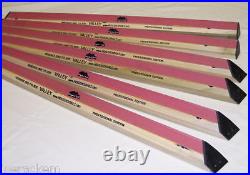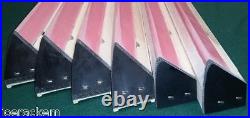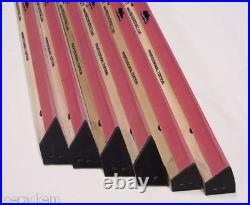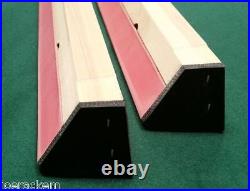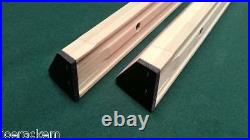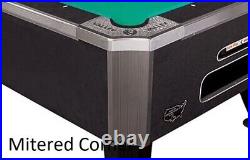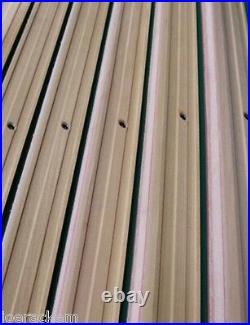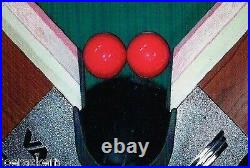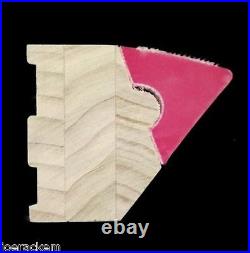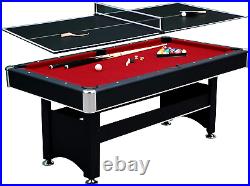Billiards Pool Akam Table RARE Early American Advertising Flyer ca 1860s
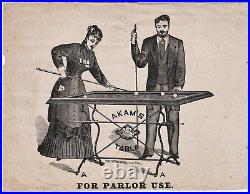
VERY RARE Advertising Flyer. Akam’s Billiard Table. For offer, a nice old postcard lot! Fresh from a prominent estate in Upstate NY. Never offered on the market until now. Vintage, Old, Original, Antique, NOT a Reproduction – Guaranteed! Leaflet / advertising trade flyer. The earliest Billiards piece I have seen. This was found folded up with various trade cards and other items from the 1860s – 1870s. One sided – back is blank. Early cast iron base, small table. Clothing lines up with the period. Man and woman with cue sticks playing the game. At bottom says For parlor use. Engraved printing, signed at bottom by Bernhard Company, Chicago. Measures 7 x 5 3/8 inches. In good to very good condition. Fold marks, light age toning. If you collect 19th century Americana history, American Victorian era photography, sporting, gaming, etc. This is a treasure you will not see again! Add this to your image or paper / ephemera collection. Cue sports (sometimes written cuesports), also known as billiard sports, [1][2] are a wide variety of games of skill generally played with a cue stick which is used to strike billiard balls, moving them around a cloth-covered billiards table bounded by rubber cushions. Historically, the umbrella term was billiards. While that familiar name is still employed by some as a generic label for all such games, the word’s usage has splintered into more exclusive competing meanings in various parts of the world. For example, in British and Australian English, “billiards” usually refers exclusively to the game of English billiards, while in American and Canadian English it is sometimes used to refer to a particular game or class of games, or to all cue games in general, depending upon dialect and context. There are three major subdivisions of games within cue sports: Carom billiards, referring to games played on tables without pockets, typically 10 feet in length, including balkline and straight rail, cushion caroms, three-cushion billiards, artistic billiards and four-ball; Pool, covering numerous pocket billiards games generally played on six-pocket tables of 7-, 8-, or 9-foot length, including among others eight-ball (the world’s most widely played cue sport), nine-ball (the dominant professional game), ten-ball, straight pool (the formerly dominant pro game), one-pocket, and bank pool; and Snooker and English billiards, games played on a billiards table with six pockets called a snooker table (which has dimensions just under 12 ft by 6 ft), that are classified entirely separately from pool based on a separate historical development, as well as a separate culture and terminology that characterize their play. There are other variants that make use of obstacles and targets, and table-top games played with disks instead of balls. Billiards has a long and rich history stretching from its inception in the 15th century, to the wrapping of the body of Mary, Queen of Scots, in her billiard table cover in 1586, through its many mentions in the works of Shakespeare, including the famous line “let’s to billiards” in Antony and Cleopatra (1606-07), and through the many famous enthusiasts of the sport such as: Mozart, Louis XIV of France, Marie Antoinette, Immanuel Kant, Napoleon, Abraham Lincoln, Mark Twain, George Washington, French president Jules Grévy, Charles Dickens, George Armstrong Custer, Theodore Roosevelt, Lewis Carroll, W. Fields, Babe Ruth, Bob Hope, and Jackie Gleason. History Inset from School of Recreation, 1710. We perceive from the engraving of the Billiards of the seventtenth century, that the game was altogether different from what it is now. [3] All cue sports are generally regarded to have evolved into indoor games from outdoor stick-and-ball lawn games (retroactively termed ground billiards), [4] and as such to be related to trucco, croquet and golf, and more distantly to the stickless bocce and balls. The word “billiard” may have evolved from the French word billart or billette, meaning “stick”, in reference to the mace, an implement similar to a golf club, which was the forerunner to the modern cue; the term’s origin may have also been from French bille, meaning “ball”. [5] The modern term “cue sports” can be used to encompass the ancestral mace games, and even the modern cueless variants, such as finger billiards, for historical reasons. “Cue” itself came from queue, the French word for a tail. This refers to the early practice of using the tail of the mace to strike the ball when it lay against a rail cushion. [5] A recognizable form of billiards was played outdoors in the 1340s, and was reminiscent of croquet. [5] Louis XIV further refined and popularized the game, and it swiftly spread among the French nobility. [5] While the game had long been played on the ground, this version appears to have died out in the 17th century, in favor of croquet, golf and bowling games, while table billiards had grown in popularity as an indoor activity. [5] Mary, Queen of Scots, claimed that her “table de billiard” had been taken away by those who eventually became her executioners (and who covered her body with the table’s cloth). [5] In 1588, the Duke of Norfolk, owned a billyard bord coered with a greene cloth… Three billyard sticks and 11 balls of yvery. [5] Billiards grew to the extent that by 1727, it was being played in almost every Paris café. [5] In England, the game was developing into a very popular activity for members of the gentry. [5] By 1670, the thin butt end of the mace began to be used not only for shots under the cushion (which itself was originally only there as a preventative method to stop balls from rolling off), but players increasingly preferred it for other shots as well. The cue as it is known today was finally developed by about 1800. [5] Initially, the mace was used to push the balls, rather than strike them. The newly developed striking cue provided a new challenge. Cushions began to be stuffed with substances to allow the balls to rebound, in order to enhance the appeal of the game. After a transitional period where only the better players would use cues, the cue came to be the first choice of equipment. [5] The demand for tables and other equipment was initially met in Europe by John Thurston and other furniture makers of the era. The early balls were made from wood and clay, but the rich preferred to use ivory. [5] Early billiard games involved various pieces of additional equipment, including the “arch” (related to the croquet hoop), “port” (a different hoop) and “king” (a pin or skittle near the arch) in the 1770s, but other game variants, relying on the cushions (and eventually on pockets cut into them), were being formed that would go on to play fundamental roles in the development of modern billiards. [5] Illustration of a three-ball pocket billiards game in early 19th century Tübingen, Germany, using a table much longer than the modern type. The early croquet-like games eventually led to the development of the carom or carambole billiards category – what most non-Commonwealth and non-US speakers mean by the word “billiards”. These games, which once completely dominated the cue sports world but have declined markedly in many areas over the last few generations, are games played with three or sometimes four balls, on a table without holes (and without obstructions or targets in most cases), in which the goal is generally to strike one object ball with a cue ball, then have the cue ball rebound off of one or more of the cushions and strike a second object ball. Variations include three-cushion, straight rail and the balkline variants, cushion caroms, five-pins, and four-ball, among others. In the United States pool and billiards had died out for a bit, but between 1878 and 1956 pool and billiards became very popular. Players in annual championships began to receive their own cigarette cards. This was mainly due to the fact that it was a popular pastime for troops to take their minds off from battle. However, by the end of World War II pool and billiards began to die down once again. It wasn’t until 1961 when the film “The Hustler” came out that sparked a new interest in the game. Now the game is generally a well-known game and has many players of all different skill levels. [6] There are few more cheerful sights, when the evenings are long, and the weather dull, than a handsome, well-lighted billiard room, with the smooth, green surface of the billiard table; the ivory balls flying noiselessly here and there, or clicking musically together. [7] -? Charles Dickens Jr. (1889) As a sport The games with regulated international professional competition, if not others, have been referred to as “sports” or “sporting” events, not simply “games”, since 1893 at the latest. [8] Quite a variety of particular games i. Sets of rules and equipment are the subject of present-day competition, including many of those already mentioned, with competition being especially broad in nine-ball, snooker, three-cushion and eight-ball. Snooker, though technically a pocket billiards variant and closely related in its equipment and origin to the game of English billiards, is a professional sport organized at the international level, and its rules bear little resemblance to those of modern pool, pyramid and other such games. A “Billiards” category encompassing pool, snooker and carom was featured in the 2005 World Games, held in Duisburg, Germany, and the 2006 Asian Games also saw the introduction of a “Cue sports” category. Equipment Main category: Cue sports equipment Billiard balls Main article: Billiard ball Cue balls from (left to right): Russian pool and kaisa-68 mm (2 11? 16 in) Carom-61.5 mm (2 7? 16 in) American-style pool-57 mm (2 1? 4 in) British-style pool (largish) -56 mm (2 3? 16 in) Snooker-52.5 mm (2 1? 15 in) Scaled-down pool-51 mm (2 in) for children’s smaller tables Not shown: half-scale children’s miniature pool-approximately 28.5 mm (1 1? 8 in). Billiard balls vary from game to game, in size, design and quantity. Russian pyramid and kaisa have a size of 68 mm (2 11? 16 in). In Russian pyramid there are sixteen balls, as in pool, but fifteen are white and numbered, and the cue ball is usually red. [9] In Kaisa, five balls are used: the yellow object ball (called the kaisa in Finnish), two red object balls, and the two white cue balls (usually differentiated by one cue ball having a dot or other marking on it and each of which serves as an object ball for the opponent). Carom billiards balls are larger than pool balls, having a diameter of 61.5 mm (2 7? 16 in), and come as a set of two cue balls (one colored or marked) and an object ball (or two object balls in the case of the game four-ball). American-style pool balls are 57 mm (2 1? 4 in), are used in many pool games found throughout the world, come in sets of two suits of object balls, seven solids and seven stripes, an 8 ball and a cue ball; the balls are racked differently for different games (some of which do not use the entire ball set). Blackball (English-style eight-ball) sets are similar, but have unmarked groups of red (or blue) and yellow balls instead of solids and stripes, and at 56 mm (2 3? 16 in) are smaller than the American-style; they are used principally in Britain, Ireland, and some Commonwealth countries, though not exclusively, since they are unsuited for playing nine-ball. Snooker balls are smaller than American-style pool balls with a diameter of 52.5 mm (2 1? 15 in), and come in sets of 22 (15 reds, 6 “colours”, and a cue ball). English billiard balls are the same size as snooker balls and come in sets of three balls (two cue balls and a red, an object ball). Other games, such as bumper pool, have custom ball sets. Billiard balls have been made from many different materials since the start of the game, including clay, bakelite, celluloid, crystallite, ivory, plastic, steel and wood. The dominant material from 1627 until the early 20th century was ivory. The search for a substitute for ivory use was not for environmental concerns but based on economic motivation and fear of danger for elephant hunters. The first viable substitute was celluloid, invented by John Wesley Hyatt in 1868, but the material was volatile, sometimes exploding during manufacture and was highly flammable. [10][11] Tables Main article: Billiard table Pool table with equipment. There are many sizes and styles of pool and billiard tables. Generally, tables are rectangles twice as long as they are wide. Most pool tables are known as 7-, 8-, or 9-footers, referring to the length of the table’s long side. Full-size snooker and English billiard tables are 12 feet (3.7 m) long on the longest side. Pool halls tend to have 9-foot (2.7 m) tables and cater to the serious pool player. Pubs will typically use 7-foot (2.1 m) tables which are often coin-operated. Formerly, 10-foot (3 m) tables were common, but such tables are now considered antique collectors items; a few, usually from the late 19th century, can be found in pool halls from time to time. Ten-foot tables remain the standard size for carom billiard games. The slates on modern carom tables are usually heated to stave off moisture and provide a consistent playing surface. The length of the pool table will typically be a function of space, with many homeowners purchasing an 8-foot (2.4 m) table as a compromise. Full-size pool tables are 4.5 by 9 ft (2.7 m) (interior dimensions). High-quality tables have a bed made of thick slate, in three pieces to prevent warping and changes due to temperature and humidity. Smaller bar tables are most commonly made with a single piece of slate. Pocket billiards tables of all types normally have six pockets, three on each side (four corner pockets, and two side or middle pockets). Cloth Main article: Baize Women playing on an elaborately decorated green-covered table in an early 1880s advertising poster. All types of tables are covered with billiard cloth (often called “felt”, but actually a woven wool or wool/nylon blend called baize). Cloth has been used to cover billiards tables since the 15th century. In fact, the predecessor company of the most famous maker of billiard cloth, Iwan Simonis, was formed in 1453. Bar or tavern tables, which get a lot of play, use “slower”, more durable cloth. The cloth used in upscale pool (and snooker) halls and home billiard rooms is “faster” i. Provides less friction, allowing the balls to roll farther across the table bed, and competition-quality pool cloth is made from 100% worsted wool. Snooker cloth traditionally has a nap (consistent fiber directionality) and balls behave differently when rolling against versus along with the nap. The cloth of the billiard table has traditionally been green, reflecting its origin (originally the grass of ancestral lawn games), and has been so colored since the 16th century, but it is also produced in other colors such as red and blue. [12] The cloth was earlier said to be the most important part of the game, most likely because of the reflection of the game’s origin. The players were stubborn in the fact that the cloth should not be ripped. They even made women continue to use maces after cues were invented, for fear that they would rip the cloth with the sharper cues. Rack Main article: Rack (billiards) Aluminium billiard rack that is used for 8-ball, 9-ball, and straight pool. A rack is the name given to a frame (usually wood, plastic or aluminium) used to organize billiard balls at the beginning of a game. This is traditionally triangular in shape, but varies with the type of billiards played. There are two main types of racks; the more common triangular shape which is used for eight-ball and straight pool and the diamond-shaped rack used for nine-ball. There are several other types of less common rack types that are also used, based on a “template” to hold the billiard balls tightly together. Most commonly it is a thin plastic sheet with diamond-shaped cut-outs that hold the balls that is placed on the table with the balls set on top of the rack. The rack is used to set up the “break” and removed after the “break shot” occurs. Cues Main article: Cue stick Billiards games are mostly played with a stick known as a cue. A cue is usually either a one piece tapered stick or a two piece stick divided in the middle by a joint of metal or phenolic resin. High quality cues are generally two pieces and are made of a hardwood, generally maple for billiards and ash for snooker. The butt end of the cue is of larger circumference and is intended to be gripped by a player’s hand. The shaft of the cue is of smaller circumference, usually tapering to an 0.4 to 0.55 inches (10 to 14 mm) terminus called a ferrule (usually made of fiberglass or brass in better cues), where a rounded leather tip is affixed, flush with the ferrule, to make final contact with balls. The tip, in conjunction with chalk, can be used to impart spin to the cue ball when it is not hit in its center. Cheap cues are generally made of pine, low-grade maple (and formerly often of ramin, which is now endangered), or other low-quality wood, with inferior plastic ferrules. A quality cue can be expensive and may be made of exotic woods and other expensive materials which are artfully inlaid in decorative patterns. Many modern cues are also made, like golf clubs, with high-tech materials such as woven graphite. Skilled players may use more than one cue during a game, including a separate generally lighter cue for the opening break shot (because of cue speed gained from a lighter stick) and another, shorter cue with a special tip for jump shots. Mechanical bridge The mechanical bridge, sometimes called a “rake”, “bridge stick” or simply “bridge”, and in the UK a “rest”, is used to extend a player’s reach on a shot where the cue ball is too far away for normal hand bridging. It consists of a stick with a grooved metal or plastic head which the cue slides on. Many amateurs refuse to use the mechanical bridge based on the perception that to do so is unmanly. [citation needed] However, many aficionados and most professionals employ the bridge whenever the intended shot so requires. Some players, especially current or former snooker players, use a screw-on cue butt extension instead of or in addition to the mechanical bridge. Bridge head design is varied, and not all designs (especially those with cue shaft-enclosing rings, or wheels on the bottom of the head), are broadly tournament-approved. In Italy a longer, thicker cue is typically available for this kind of tricky shot. For snooker they are normally available in three forms, their use depending on how the player is hampered; the standard rest is a simple cross, the’spider’ has a raised arch around 12 cm with three grooves to rest the cue in and for the most awkward of shots, the’giraffe’ (or’swan’ in England) which has a raised arch much like the’spider’ but with a slender arm reaching out around 15 cm with the groove. Chalk Billiard chalk is applied to the tip of the cue. Chalk is applied to the tip of the cue stick, ideally before every shot, to increase the tip’s friction coefficient so that when it impacts the cue ball on a non-center hit, no miscue (unintentional slippage between the cue tip and the struck ball) occurs. Cue tip chalk is not actually the substance typically referred to as “chalk” (generally calcium carbonate, also known as calcite or carbonate of lime), but any of several proprietary compounds, with a silicate base. It was around the time of the Industrial Revolution that newer compounds formed that provided better grip for the ball. This is when the English began to experiment with side spin or applying curl to the ball. This was shortly introduced to the American players and is how the term “putting English on the ball” came to be. “Chalk” may also refer to a cone of fine, white hand chalk; like talc (talcum powder) it can be used to reduce friction between the cue and bridge hand during shooting, for a smoother stroke. Some brands of hand chalk actually are made of compressed talc. Tip chalk is not used for this purpose because it is abrasive, hand-staining and difficult to apply. Many players prefer a slick pool glove over hand chalk or talc because of the messiness of these powders; buildup of particles on the cloth will affect ball behavior and necessitate more-frequent cloth cleaning. Cue tip chalk invented in its modern form by straight rail billiard pro William A. Spinks and chemist William Hoskins in 1897[13][14] is made by crushing silica and the abrasive substance corundum or aloxite[14] (aluminium oxide), [15][16] into a powder. [14] It is combined with dye (originally and most commonly green or blue-green, like traditional billiard cloth, but available today, like the cloth, in many colors) and a binder (glue). High humidity can also impair the effectiveness of chalk. Harder, drier compounds are generally considered superior by most players. Major games There are two main varieties of billiard games: carom and pocket. The main carom billiards games are straight rail, balkline and especially three cushion billiards. All are played on a pocketless table with three balls; two cue balls and one object ball. In all, players shoot a cue ball so that it makes contact with the opponent’s cue ball as well as the object ball. Others of multinational interest are four-ball and five-pins. The most globally popular of the large variety of pocket games are Pool and snooker. English billiards, with some features of carom billiards, was one of the two most-competitive cue sports, along with balkline, at the turn of the previous century and is still enjoyed today especially in Commonwealth countries. Russian pyramid and its variants like kaisa are popular in the former Eastern bloc. Man playing billiards with a cue and a woman with mace, from an illustration appearing in Michael Phelan’s 1859 book, The Game of Billiards. Games played on a carom billiards table Main article: Carom billiards Straight rail or straight billiards Main article: Balkline and straight rail In straight rail, a player scores a point and may continue shooting each time his cue ball makes contact with both other balls. Although a difficult and subtle game, some of the best players of straight billiards developed the skill to gather the balls in a corner or along the same rail for the purpose of playing a series of nurse shots to score a seemingly limitless number of points. The first straight rail professional tournament was held in 1879 where Jacob Schaefer, Sr. Scored 690 points in a single turn[12][page needed] (that is, 690 separate strokes without a miss). With the balls repetitively hit and barely moving in endless “nursing”, there was little for the fans to watch. Balkline Main article: Balkline and straight rail In light of these phenomenal skill developments in straight rail, the game of balkline soon developed to make it impossible for a player to keep the balls gathered in one part of the table for long, greatly limiting the effectiveness of nurse shots. A balkline (not to be confused with baulk line, which pertains to the game of English billiards) is a line parallel to one end of a billiards table. In the games of balkline – 18.1 and 18.2 (pronounced “eighteen-point-two”) balkline, among other more obscure variations – the players have to drive at least one object ball past a balkline set at 18 inches (460 mm) from each rail, after one or two points have been scored, respectively. Three-cushion billiards Main article: Three-cushion billiards A more elegant solution was three-cushion billiards, which requires a player to make contact with the other two balls on the table and contact three rail cushions in the process. This is difficult enough that even the best players can only manage to average one to two points per turn. Games played on a pool table Main article: Pool (cue sports) There are many variations of games played on a standard pool table. Popular pool games include eight-ball, nine-ball, straight pool and one-pocket. Even within games types e. Eight-ball, there may be variations, and people may play recreationally using relaxed or local rules. A few of the more popular examples of pool games are given below. Well-known but waning in popularity is straight pool, in which players seek to continue sinking balls, rack after rack if they can, to reach a pre-determined winning score (typically 150). Related to nine-ball, another well-known game is rotation, where the lowest-numbered object ball on the table must be struck first, although any object ball may be pocketed i. Each pocketed ball is worth its number, and the player with the highest score at the end of the rack is the winner. Since there are only 120 points available (1 + 2 + 3? + 15 = 120), scoring 61 points leaves no opportunity for the opponent to catch up. In both one-pocket and bank pool, the players must sink a set number of balls; respectively, all in a particular pocket, or all by bank shots. In snooker, players score points by alternately potting red balls and various special “colour balls”. Two-player or -team games Eight-ball: The goal is to pocket (pot) all of one’s designated group of balls either stripes vs. Solids, or reds vs. Yellows, depending upon the equipment, and then pocket the 8 ball in a called pocket. 14.1 continuous pool: The goal is to reach a predetermined number of points e. 100; a point is earned by pocketing any called ball into a designated pocket; game play is by racks of 15 balls, and the last object ball of a rack is not pocketed, but left on the table with the opponent re-racking the remaining 14 before game play continues. Bank pool: The goal is to reach a predetermined number of points; a point is earned by pocketing any called ball by banking it into a designated pocket using one or more cushion. Speed pool Speed pool is a standard billiards game where the balls must be pocketed in as little time as possible. Rules vary greatly from tournament to tournament. The International Speed Pool Challenge has been held annually since 2006. Games played on a snooker table English billiards Main article: English billiards Dating to approximately 1800, English billiards, called simply billiards[5] in many former British colonies and in Great Britain where it originated, was originally called the winning and losing carambole game, folding in the names of three predecessor games, the winning game, the losing game and the carambole game (an early form of straight rail), that combined to form it. [18] The game features both cannons (caroms) and the pocketing of balls as objects of play. English billiards requires two cue balls and a red object ball. The object of the game is to score either a fixed number of points, or score the most points within a set time frame, determined at the start of the game. Points are awarded for: Two-ball cannons: striking both the object ball and the other (opponent’s) cue ball on the same shot (2 points). Winning hazards: potting the red ball (3 points); potting the other cue ball (2 points). Losing hazards (or “in-offs”): potting one’s cue ball by cannoning off another ball 3 points if the red ball was hit first; 2 points if the other cue ball was hit first, or if the red and other cue ball were “split”, i. Snooker Main article: Snooker Snooker is a pocket billiards game originated by British officers stationed in India during the 19th century, based on earlier pool games such as black pool and life pool. The name of the game became generalized to also describe one of its prime strategies: to “snooker” the opposing player by causing that player to foul or leave an opening to be exploited. In the United Kingdom, snooker is by far the most popular cue sport at the competitive level, and major national pastime along with association football and cricket. It is played in many Commonwealth countries as well, especially in Asia. Snooker is uncommon in North America, where pool games such as eight-ball and nine-ball dominate, and Latin America and Continental Europe, where carom games dominate. The first World Snooker Championship was held in 1927, and it has been held annually since then with few exceptions. The World Professional Billiards and Snooker Association (WPBSA) was established in 1968 to regulate the professional game, while the International Billiards and Snooker Federation (IBSF) regulates the amateur games. List of cue sports and games Carom games Main article: Carom billiards Main category: Carom billiards Artistic billiards (a major world cue sport) Balkline games 18.1, 18.2, etc. Four-ball (yotsudama, sagu) Straight-rail Three-cushion billiards (a major world cue sport) See also “Hybrid games”, below. Target carom games Five-pin billiards (a major international cue sport) Goriziana (or nine-pin billiards) Pocket games Main article: Pocket billiards Pool games Main category: Pool (cue sports) American rotation Artistic pool (a major world cue sport) Bank pool Baseball pocket billiards Bowlliards Chicago Cribbage Cutthroat Eight-ball a major world cue sport; informally a. Stripes & solids, or highs & lows Blackball a. Eightball pool, British-style eight-ball “Chinese” eight-ball Equal offense Fifteen-ball Honolulu Kelly pool Killer Nine-ball (a major world cue sport) One-pocket (a major world cue sport) Rotation a. 61 Seven-ball Speed pool Straight pool a major world cue sport; a. 14.1 continuous Ten-ball (a major world cue sport) Three-ball Non-pool pocket games Golf billiards (and its variant, around-the-world) Russian pyramid (a major cue sport in Eastern Europe and countries of the former USSR) See also “Snooker games” and “Hybrid games”, below. Snooker games Main category: Snooker Technically a form of pocket billiards, snooker has its own world-wide sporting community separate from that of pool. Snooker (a major world cue sport) Six-red snooker American snooker Brazilian snooker Volunteer snooker Snooker plus See also golf billiards, above. Hybrid carom and pocket games These combine aspects of carom and pocket billiards, and are played on tables with pockets (often as hazards not targets). Bottle pool Cowboy pool English billiards (a major world cue sport) Five-pin billiards, historically Poker pool Kaisa Obstacle and target games Main category: Obstacle billiards Bagatelle (obsolete) Bar billiards Bumper pool Danish pin billiards and other pin billiards games Devil’s pool and victory billiards Bottle pool, skittle pool (pin pool), and Italian five-pin billiards and goriziana are vestigially classifiable here as well Disk games These are variations using small disks instead of balls, and light-weight cue sticks. Carrom (some variants of this table-top game use miniature cues; mostly played with the hands) Crokinole (some variants of this combination of carrom and shuffleboard use miniature cues) Novuss (uses full-length cues) Ground games Main category: Ground billiards Outdoor games played on a lawn, field or court, played with varying equipment that may include hoops, pins, holes or other targets or obstacles, and clubs, curved-head sticks, or mallets. Most such games are obsolete, aside from croquet. Golf and field hockey, as well as stick-less games such as bocce, boules and bowls, are historically related. Finger billiards or hand billiards (on a carom table) Boccette (an adaptation of five-pin billiards to cueless play) Finger pool (on a pool table) Crud (the only billiards-based contact sport) Bocce billiards or bocce pool (an adaptation of the lawn game bocce to billiard or pool tables).
